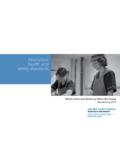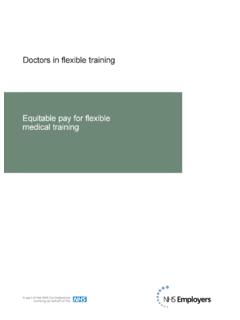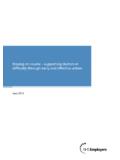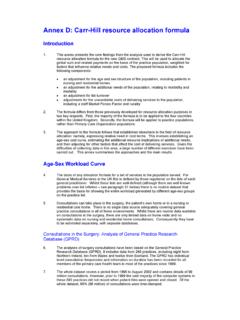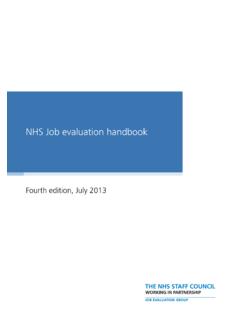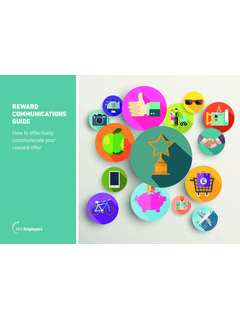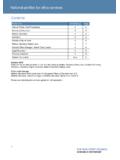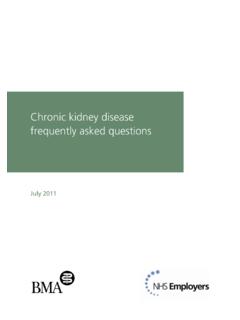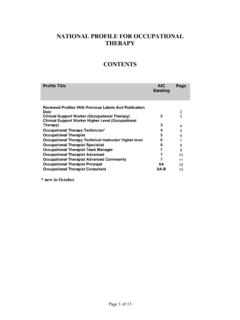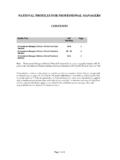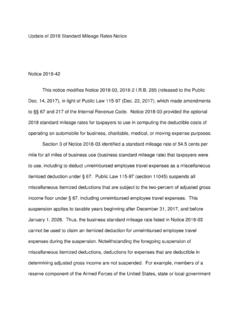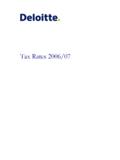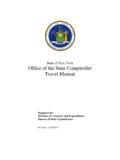Transcription of Review of the reimbursement of travel expenses 12 …
1 Review of the reimbursement of travel expenses October 2010 Contents Review of the reimbursement of travel expenses 1 Current arrangements 1 What is being proposed - overview? 1 Proposals in more detail 3 On-going Review of mileage rates 3 Calculating the cost of fuel 4 Reserve rate 4 Lease cars 5 The environmental agenda (the green agenda) 5 Timetable for implementation 5 Annex 1 6 Background 6 Calculating reimbursements in the NHS 6 Consultation on proposed changes in 2009 6 Principles for agreeing new arrangements 6 Current system of allowances and payments 7 Additional allowances 8 Annex 2 9 Standard methodologies for calculating the costs of motoring 9 The AA guides to motoring costs 9 Standing charges 10 Running costs 10 1 Review of the reimbursement of travel expenses Working in partnership as a sub-group of the NHS Staff Council.
2 The Council s mileage sub group which has both employer and trades union representatives - has been reviewing the allowances paid to staff who use their own vehicles on official business. The Review aimed to deliver a national system for reimbursements which meets the needs of staff, employers and the service in line with principles for any new arrangements: fair to staff, easy to use and transparent, with built-in partnership reviews of allowances, to ensure they cover costs incurred. This briefing gives employers and staff information about the NHS Staff Council s proposals for a new system of reimbursement of travel expenses . The document contains: - a description of the proposed new system of reimbursing travel costs; and - background information about mileage allowances and the Review (see annexes).
3 Current arrangements The NHS has a responsibility to reimburse costs incurred by staff who use their own vehicles to travel on NHS business. The national rates of reimbursement currently in the Handbook were last uprated in July 2008 in response to rapid increases in fuel prices at that time. Subsequently fuel prices and other motoring costs have changed. However, the NHS Staff Council has no agreed way of measuring these changes and, therefore, of checking if rates of reimbursement have kept track with changes in costs. Yet it is essential that nationally agreed rates appropriately reimburse staff for the costs they incur when they use their own vehicles for work purposes. The current arrangements are set out in Section 17 and Annex L and Annex M of the NHS terms and conditions of service handbook.
4 What is being proposed - overview? The proposals have been developed following a consultation with NHS employers and trades unions which indicated a preference for a single rate of reimbursement and use of the AA guides as the reference for the costs of business motoring for the NHS. The sub-group believes this will ensure an authoritative and independent point of reference that reflects the true cost of motoring. From 1 July 2013 we are proposing a system of reimbursement of the cost of miles travelled on NHS business to replace the existing system of payments and allowances. In keeping with the principles we have agreed we are proposing a simpler system based on a standard rate of reimbursement up to a maximum annual mileage after which the rate changes. The distinction between regular and standard car users would be abolished and there would be no reference to engine size.
5 All travellers, irrespective of the frequency of their journeys 2 and the vehicle they drive, would receive the same rate of reimbursement . There would be a separate rate of reimbursement for motorcycle and bicycle users. Feedback from the consultation exercise indicated that staff and managers regarded certain allowances for carrying passengers and heavy and/or bulky equipment as important and we propose that these should continue to be part of the new system of reimbursement . We recognise that it is necessary to ensure that the average car user is appropriately reimbursed. It is not possible to have a national system that reflects each individuals costs or personal circumstances. The single rate will be set at a figure that we believe, as accurately as possible, reflects the costs to the average car user.
6 Our proposals, which are outlined in more detail on NHS Employers website, are summarised below: - a single rate of reimbursement for all private car users, which would be reviewed twice a year; - rates of reimbursement which will move in line with business motoring costs; - using independently sourced information on costs via the AA; - reimbursement based on the average costs of running a car in the AA s estimate of a mid-range of price and size; - an increase in the rates for pedal cycle users; - rates for motor-cycle users to be 50 per cent of the proposed new standard rate of reimbursement for vehicle users; - continuation of excess travel expenses for staff required to change base as a result of organisational change; - any local agreements will be honoured; - half of the value of interest on capital (money) which an individual may otherwise invest if it had not been spent on the car (the cost of capital) is taken into account in setting the standard rate of reimbursement ; - a change of reimbursement rates triggered when a change in overall motoring costs produces an increase or decrease above or below 5%; - a small increase in the allowance for carrying bulky and/or heavy equipment; - payment of the full standard mileage rate when staff are required to attend training courses or events away from their normal base; 3 - a reserve rate of reimbursement to replace the Public Transport Rate (PTR) which would be 50 per cent of the proposed new standard mileage rate.
7 - elements which address concerns expressed by the Sustainable Development Unit (SDU) and other organisations concerned with the green agenda . The rates of reimbursement which would apply if the proposed system were in use today are in the Table below. Proposed rates of reimbursement at 1 July 2010 costs Column 1 Column 2 Column 3 Column 4 Type of vehicle/allowance Annual mileage up to 3,500 miles (standard rate) Annual mileage over 3,500 miles (standard rate) All eligible miles travelled (see paragraph and Table 9)Car (all types of fuel) 54 pence per mile 18 pence per mile Motor cycle 27 pence per mile Pedal cycle 20 pence per mile Passenger allowance 5 pence per mile Reserve rate 27 pence per mile Carrying heavy or bulky equipment 3 pence per mile These proposed rates and the proposed new qualifying conditions would apply to all journeys made on and after 1 July 2013.
8 There would be no changes to mileage allowances and the qualifying conditions in the national Handbook before then. Proposals in more detail Our proposals include a new system for working out what the costs of business motoring are. This is set out in the proposed new Annex L which would be incorporated into the revised terms and conditions of service handbook. Annex L shows how the list of costs in the AA guides would be taken into account in setting the standard rate of reimbursement . On-going Review of mileage rates We are proposing that the new standard rate of reimbursement should be reviewed twice each year: 4 the first Review would take place as soon as possible after the publication of the new AA guides (normally in April or May). The new values of the cost items listed in the guides would be used to update the values in Table 22 in Annex L and the change in the standard rate produced would be compared to its value at the time the standard rate was last changed.
9 A change in the standard rate of more than, up or down, would lead to rates being adjusted for mileage undertaken from the following 1 July; a second Review in October would look specifically at the average fuel price in the twelve month period ending in October. A change in the standard rate after this Review would depend on the same rules as for the April/May Review and would apply from the following 1 January. During the period leading up to the implementation of the new Section 17, Annex L and Annex M on 1 July 2013, the NHS Staff Council would check the rates of reimbursement being proposed using the procedures for Review set out in the proposals. Any changes to the proposed standard and related rates of reimbursement resulting from these reviews, would be published in pay circulars so that local partnerships could keep track of changes in the proposed new rates of reimbursement until they are implemented on 1 July 2013.
10 The rates implemented on 1 July 2013, would be those resulting from the Review which would be done following the publication of the new AA guides in April/May 2013. Those rates would apply to all journeys undertaken on and after 1 July 2013. Calculating the cost of fuel It is the cost of fuel that is often the trigger for concerns over reimbursement for business travel . However, the AA estimates that the biggest single cost item is depreciation, which is a standing cost , rather than a running cost . All items in the AA s list of motoring costs are calculated in terms of their cost per mile travelled. Under the proposed new arrangements, the cost of fuel is calculated this way, referenced to the average cost over the last twelve months. An example of how this works is below.
